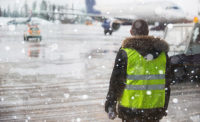Certain health-related factors can also place workers at increased risk, including:
Health conditions such as cardiovascular disease, diabetes and hypertension.
Drug use and certain prescription medications (check with a health care professional)
Age, poor physical condition and a poor diet
When possible, workers should avoid exposure to extremely cold temperatures.
However, when cold environments and temperatures cannot be avoided, OSHA and the CDC recommend ways to help prevent cold-related injuries and illnesses, including:
Recognize the environmental and workplace conditions that lead to potential cold-induced illnesses and injuries.
Schedule maintenance and repair jobs in cold areas for warmer months.
Perform work during the warmest part of the day.
Reduce the physical demands of workers.
Avoid exhaustion or fatigue because energy is needed to keep muscles warm.
Use the buddy system (work in pairs).
Use relief workers or assign extra workers for long, demanding jobs.
Provide warm, sweet beverages (sugar water, sports-type drinks). Workers should avoid drinks with caffeine (coffee, tea or hot chocolate) or alcohol.
Eat warm, high-calorie foods like hot pasta dishes.
Monitor at-risk workers
Train the workforce about cold-induced illnesses and injuries, including how to recognize symptoms and treat affected workers.
Take frequent short breaks in warm dry areas; limit the amount of time outside on extremely cold days.
Carry cold weather gear, such as extra socks, gloves, hats, jacket, blankets, a change of clothes and a thermos of hot liquid.
Include a thermometer and chemical hot packs in your first aid kit.
Avoid touching cold metal surfaces with
bare skin.
Select proper clothing for cold, wet and windy conditions.
Wear several layers of loose clothing. Layering provides better insulation.
Tight clothing reduces blood circulation. Warm blood needs to be circulated to the extremities.
When choosing clothing, be aware that some clothing may restrict movement resulting in a hazardous situation.
Make sure to protect the ears, face, hands and feet in extremely cold weather.
Boots should be waterproof and insulated.
Wear a hat; it will keep your whole body warmer. (Hats reduce the amount of body heat that escapes from your head.)
Proper PPE is key
The right clothing is vital in cold environments. Clothing that provides the right level of insulation will keep workers protected and comfortable and can have a positive impact on productivity, endurance and safety. To help both users and buyers of insulating apparel select the right garments to meet their needs, the International Safety Equipment Association (ISEA) published the American National Standard for Classification of Insulating Apparel Used in Cold Work Environments (ANSI/ISEA 201-2012) in March. This voluntary industry consensus standard serves as a tool for rating insulated garments.
“When you’re operating in extreme cold conditions, it’s a challenge to find apparel that will keep workers comfortable and still allow them to do their jobs,” said Cristine Fargo, ISEA director of member and technical services. “This standard provides an objective way to measure and show insulating performance, and gives users an important tool for selecting the right garment.”
Manufacturers test a garment’s insulating value after a specified number of washing or dry cleaning cycles and assign a thermal performance category based on the results. The intrinsic insulating value is expressed in clo. One clo is the insulation needed to maintain body temperature for a person seated in a 70-degree F room, roughly equivalent to a business suit.
The thermal performance category and corresponding temperature range are displayed on the garment’s label, along with a durability classification to show how many laundering cycles were performed before testing. These figures are designed to inform the user how the garment will perform at various levels of exertion, and how it is expected retain its insulating properties over time.
The standard also includes guidelines for selection of thermal insulating apparel, to give specifiers, purchasers and users a way to evaluate garments based on environmental conditions, work being performed and other factors such as the need for dexterity and mobility.
To order a copy of the standard, visit www.safetyequipment.org. To view or download a how-to guide that breaks down the standard for suppliers and workers alike, visit http://news.3m.com/press-kit/ansi-201-made-easy.
Sources
• Centers for Disease Control & Prevention, Workplace Safety & Health Topics, Cold Stress, http://www.cdc.gov/niosh/topics/coldstress/
• OSHA, http://www.osha.gov/Publications/osha3156.pdf
• International Safety Equipment Association, http://www.safetyequipment.org/c/std201-2012.cfm
• International Safety Equipment Association, http://safetyequipment.org/news/newsDetail.cfm?NewsID=83&goback=%2Egde_3098039_member_101424066







